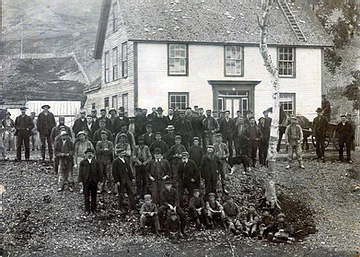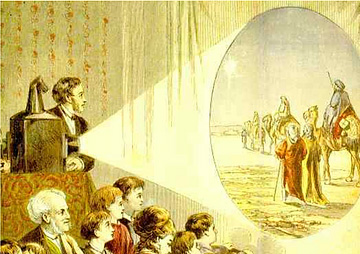Little Bay was a prosperous and cosmopolitan town in the 19th century. It was unusual for its time and place. However, while there was variety in its resident’s nationalities and a mixture of languages could be heard spoken on its streets, the population was pulled from the world’s colonial powers. Little Bay’s story is part of the tale of colonialism and its necessary to understand it in that context. The story of mine manager Wallace will make that clear.
After the departure of the baron much of Little Bay’s German culture was gone and apart from Mr. Hacker I can find no Germans in the town after 1881. The Newfoundland Consolidated Mining Company had taken over by then. The Newfoundland Consolidated Mining Company was associated with corruption and they appointed Mr. Edward Clement Wallace as mine manager. Mr. Wallace lacked the baron’s vision for community building and his shady dealings were devoid of the larger purpose which seemingly motivated the baron, making Mr. Wallace a much less sympathetic character. Under his leadership things went from shady to downright dark in Little Bay.
E. C. Wallace was born in Australia and likely had a privileged upbringing there. His father was a famous preacher named John Wallace and his mother was Marion Kezia Jane Agnes Greenway. Their son was educated as a mining engineer and when he arrived in Little Bay in 1881 he was 28 years old.
 While there is a kind letter written to him upon his departure, it is the only friendly reference to his time in Little Bay I’ve found. No other Newfoundland source I’ve located paints him in a positive light. The rest are unflinchingly unkind and it’s easily concluded that he was not well liked. In fact some sources directly blame him for the sad state of mining across the colony in the early 1880s. Under his leadership production decreased and workers were laid off. The appointments he made put men in positions of power unsuited to them and seem to have been based on nepotism alone. The deals he made as mine manager benefitted the wealthy but not the community nor the mine itself.
While there is a kind letter written to him upon his departure, it is the only friendly reference to his time in Little Bay I’ve found. No other Newfoundland source I’ve located paints him in a positive light. The rest are unflinchingly unkind and it’s easily concluded that he was not well liked. In fact some sources directly blame him for the sad state of mining across the colony in the early 1880s. Under his leadership production decreased and workers were laid off. The appointments he made put men in positions of power unsuited to them and seem to have been based on nepotism alone. The deals he made as mine manager benefitted the wealthy but not the community nor the mine itself.
An undercover journalist sent to the town pointed to Mr. Wallace as the one responsible for structuring a series of schemes which maintained greater inequality in the town in the years following the baron’s departure. There was an obvious class divide in Little Bay which was largely split between professionals and labourers and with the German population gone the split was made more obvious. Under Mr. Wallace the two groups found differences in access to media and secret tariffs on incoming goods moved more money from the miner’s pockets into the hands of Wallace’s upperclass friends.
Postmaster Walsh appears to have amassed greater control over the media during this time. With the upperclass granted access to incoming news first and also gaining greater control over when information went out from the town. Mr. Berteau, who worked as paymaster Lind’s assistant, made himself a fortune by taking a middle man position on the massive shipments of goods steadily arriving from St. John’s. Mr. Berteau was just a teenager and obtained the post when his father became Magistrate of Twillingate. These are just some examples of Wallace’s influence. While this unequal setup was facilitated by Mr. Wallace while he functioned as mine manager it’s difficult to frame it as a conspiracy by mine management as it did little to benefit the mine. I can only assume Wallace was even profiting off of these endeavours himself because as far as I can tell he was just doing favours for the aristocracy because he could.
 In this context I imagine his part in the local high brow culture as motivated by ego. He seems less concerned with fulfilling his position than he was revelling in the spotlight it offered. Nevertheless, it should be noted that he made the opening and closing remarks at the performances in the Public Hall during his tenure and operated the magic lanterns there.
In this context I imagine his part in the local high brow culture as motivated by ego. He seems less concerned with fulfilling his position than he was revelling in the spotlight it offered. Nevertheless, it should be noted that he made the opening and closing remarks at the performances in the Public Hall during his tenure and operated the magic lanterns there.
He wasn’t paying enough attention to the mine and at the same time he was also making life more difficult for the miners. Less men were working and the cost of living was on the rise. The working class were getting concerned for their livelihood while the upper class were busy yacht racing and reciting classic literature. All of this in concert with an active Temperance Movement working to close down the town’s taverns and games. This wasn’t sitting very well with the miners. The 1883 layoff of 100 men was the final straw and under the not-so watchful eye of their management, the miners secretly organized and formed what must have been one of the first unions on the island. In April of 1883 Little Bay Mine’s union stopped all production and shut the whole operation down. Wallace had little choice, he declared himself in support of the union and agreed to divide work equally among Little Bay’s miners.
Maybe it was this which finally upset his superiors. In any case, Mr. Wallace came out of favour with the Newfoundland Consolidated Mining Company and in 1885 they gave him the boot. He was replaced by Mr. White. Described as a shrewd Scotchman, the new leader was difficult but effective and well received. The bad taste left by Mr. Wallace likely helped his reputation.
 After leaving Newfoundland Edward Clement Wallace ended up in Africa. He married Kate Rynie of South Africa but she died in Johannesburg at the age of 30 in 1892. They had one son – John Rynie Wallace. In 1896 I find E. C. Wallace connected to the Crescens (Matabele) Mines and Land Company. He was injured in Zimbabwe during the Matabeli Revolt at the beginning of the Second Matabele War. I lose track of him after that but a few Spanish sources hint that he may have ended up somewhere in South America.
After leaving Newfoundland Edward Clement Wallace ended up in Africa. He married Kate Rynie of South Africa but she died in Johannesburg at the age of 30 in 1892. They had one son – John Rynie Wallace. In 1896 I find E. C. Wallace connected to the Crescens (Matabele) Mines and Land Company. He was injured in Zimbabwe during the Matabeli Revolt at the beginning of the Second Matabele War. I lose track of him after that but a few Spanish sources hint that he may have ended up somewhere in South America.
There was one other Wallace family in Little Bay in the 19th century – Robert and Martha and their son Robert but I find it unlikely they were related. I’ve yet to definitively identify a picture of Mr. Wallace, however, the “Pay Day at the Mine” photo included in this article depicts the mine management in the front row and while I cannot be certain of its date I believe I can identify Mr. Stewart in the image making the manager either Wallace or White – one of them is depicted here standing front and centre.
The sources for this article are diverse and international but luckily most were free to access this time but that’s not always the case. There are some costs associated with this research not to mention an enormous sacrifice of time. If you’d like to support this project you can do so – here. These articles occasionally reach descendants or researchers who can send me new sources or material so thanks for sharing my work and please continue to do so. I’m grateful just to have a readership, however, so most importantly and as always, thanks for reading!
